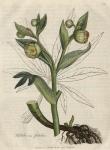
 Also see 018. Helleborus niger. Black hellebore, or, Christmas rose.
Also see 018. Helleborus niger. Black hellebore, or, Christmas rose.
Synonyma. Helleboraster. Pharm. Lond.
Helleborus Niger Foetidus. Bauh. Pin. 185.
Helleboraster maximus flore & femine praegnans. Lobel. p. 679.
Helleboraster maximus. Gerard. Herb. p. 977.
Helleborus maximus sive Consiligo. Park. t. 212.
Helleborus cause ramoso, multifloro, foliis multipartitis, serratis, stipulis ovato-lanceolatis, coloratis. Hallers Stirp. Helv. p. 1193.
Elleborus niger sylvestris adulterinus etiam hyeme virens. J. Bauh. 3. p. 880.
Veratrum nigrum 3. Dodon. Pempt. 382.
Great Black Hellebore, or Bear's-Foot. Setterwort, Raii. Synopsis, p. 271. Withering's Bot. Arran. 582. Relhans Flor. Cant. p. 218.
Class Polyandria. Order Polygynia. L. Gen. Plant. 702.
Ess. Gen. Ch. Cal. o. Petala 5 s. plura. Nectaria bilabiata, tubulata. Caps. polyspermae, erectiusculae.
Spec. Char. H. cause multifloro folioso, foliis pedatis.
The root is small, but beset with a prodigious number of slender dark coloured fibres; [Gerard's description we find very just. "The root consiteth of many small black strings, involved or wrapped one within another very intricately." Johnson's Gerard, 977.] the stem rises to the height of a foot and a half, or more, towards the bottom it is round, strong, firm, naked,and marked with alternate cicatrices, the vestiges of the former leaves; at the top it divides and subdivides into branches, producing many flowers, and is garnished with scaly leaves, or bracteae; the leaves are numerous, and stand upon long footstalks, surrounding the middle of the stem; they are divided like the Helleborus niger into simple leaves, which are commonly eight or nine, long, narrow, lanceolated, serrated, and of a dark green colour; the scaly leaves, placed at the ramifications of the flower stem, are smooth, trifid, alternate, and often purplish, but those near the flowers are oval and pointed; the flowers are numerous, terminal, pendent, of a roundish shape, and stand upon peduncles, forming a sort of umbel; the petals are five, oval, concave, persistent, of a pale green colour, and their margins are usually tinged with purple; the stamina are the length of the petals; the anthers are white; the germina three, hairy, and shaped similarly to those of the Helleborus niger. This plant grows wild in many parts of England, and flowers about February.
The Helleborus niger, though constantly used in medicine since the time of Hippocrates, was the only species of Hellebore [It must be observed, that the Heleborus Albus of the shops, is a Veratrum.] known in the Materia Medica of our pharmacopoeias, till the late introduction of this plant by the London College, probably upon the authority of Dr. Billet, who recommends the leaves as possessing extraordinary anthelminthic powers. The smell of the recent plant is extremely fetid, and the taste is bitter, and remarkably acrid, insomuch, that when chewed, it excoriates the mouth and fauces; it commonly operates as a cathartic, sometimes as an emetic, and in large doses proves highly deleterious. [Vide Threlkeld's Irish Herbal; and in the Oxford Magazine for March 1769, p. 99. fatal cases are related by John Cook of Oxford.] The leaves, the only part noticed by the College, have been long domestically employed in this country for their vermifuge effects, and are thus spoken of by Gerard:—"The leaves of bastard Hellebor, dried in an oven, after the bread is drawne out, and the pouder thereof taken in a figge or raisin, or strawed upon a piece of bread spread with honey, and eaten, killeth worms in children exceedingly."[Gerard, l. c.] —Bisset says, "The great bastard black Hellebore, or Bear's-Foot, is by far the most powerful vermifuge for long round worms of any I have yet experienced. The anthelmintic virtue of this plant is well known to the vulgar in the Dutchy of Cleveland, Yorkshire, who generally give it to their children when they suspect them to have worms. The decoction of about a dram of the green leaves, or about fifteen grains of the dried leaves in powder, is the usual dose administered to children betwixt four and seven years of age; a full or sufficient dose generally proves more or less emetic, and often loosens the belly a little. It is usually repeated on two, and sometimes three successive mornings. The second dose has commonly a greater effect than the first, and never fails to expel round worms by stool, if there be any lodged in the alimentary tube."
"The juice of the green leaves of the Bear's-Foot, made into a syrup with coarse sugar, is almost the only vermifuge I have used against round worms for three years past. Before pressing out the juice, I moisten the bruised leaves, which are a little succulent, with some vinegar, which is a corrector of this medicine, and prevents it from inducing great sickness, or much vomiting. Of this syrup I give one tea-spoonful at bed-time, and one or two in the morning, on two or three successive days, to children betwixt two and six years of age; increasing or diminishing the dose a little, according to the strength of the patient." [An Essay on the Medical Constitution of Great Britain, p. 235. and p. 339. Dr. B. speaks of this plant as useful also in some asthmatic and hypochondriacal disorders. We have tried the anthelmintic effects of this plant upon a girl of twenty years of age, (a patient in the Middlesex Dispensary) with considerable advantage.] When this does not open the body, an equal quantity of tincture of rhubarb is directed to be added.

